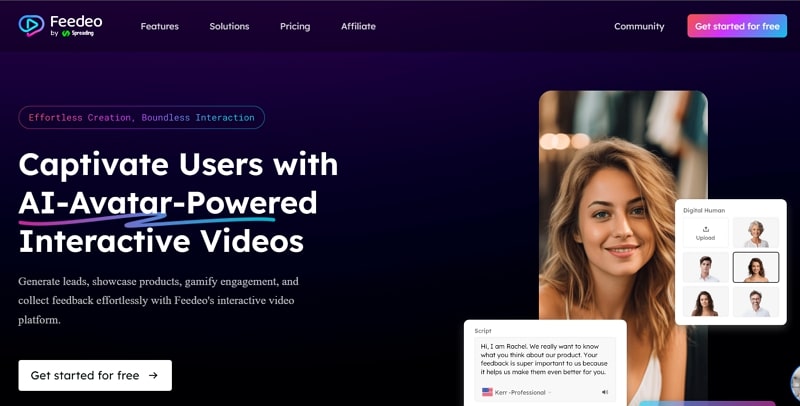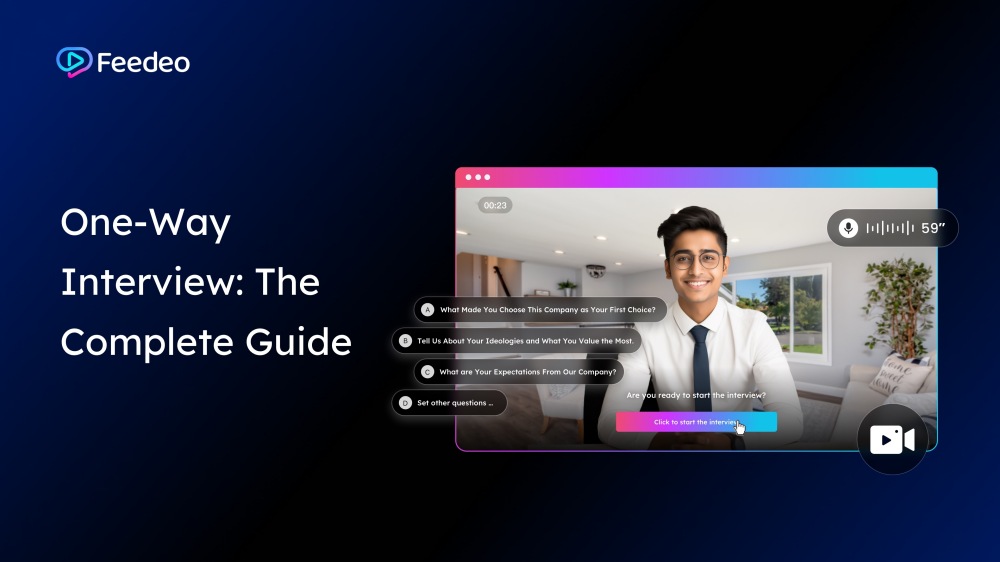Traditional hiring methods encounter challenges like conflicting schedules and the drawbacks of standardized assessments. Additionally, face-to-face or live virtual interviews are time-consuming, costly, and susceptible to biases. In response to these issues, many companies are embracing one-way video interviews. In this article, we’ll discuss the concept, necessity, functionalities, and ways to stand out in the one-way interview.
What is a One-Way Video Interview?
During the one-way interview, a candidate is asked to respond to prearranged interview questions through recorded video. The recruiter assesses the answers to determine the candidate’s suitability for the next stage. Additionally, it resembles a video-based phone interview without real-time interaction. While recognizing concerns about limited personal interaction and potential biases, organizations can adopt strategies to address these issues.
In addition, this approach maintains evaluation consistency and cuts down on expenses related to travel and logistics. Integrating additional assessment approaches and open communication with the employee’s commitment to fairness signifies a move toward a more inclusive hiring process.
Why Do Employers Use One-Way Video Interviews?
Companies’ methods of finding new employees have significantly changed due to technological advancements in the past few years. An interesting shift is the use of one-way video interviews, a departure from the traditional hiring methods. Now, let’s understand why employers use this method and how technology makes it more efficient and inclusive.
- Scalability: These are super adaptable for efficiently evaluating many candidates. So, recruiters can easily handle and review a high volume of applicants, especially for early-stage positions, without compromising the quality of assessment.
- Enhanced Screening: Video interviews offer valuable insights into candidates’ communication skills and presentation abilities. Moreover, this helps employers evaluate soft skills and cultural fit early in the hiring process to decide which candidates to invite for further stages of assessment.
- Geographical Flexibility: Due to the increase in remote work and a globalized talent pool, one-way video interviews offer a solution to location challenges. So, candidates from different places or time zones can participate without having to travel, broadening the hiring process’s scope.
- Consistency in Evaluation: One-way interviews ensure that every candidate responds to the same questions to promote a standardized evaluation process. In this way, recruiters compare candidates objectively by concentrating on their responses.
How Do One-Way Interviews Work?
One-way interviews, called asynchronous video interviews, follow a structured process where candidates record answers to predetermined questions. They use technology to make hiring more adaptable, scalable, and efficient, benefiting both candidates and employers. Here’s a step-by-step look at how they usually work and open the gateway of creativity for the hiring process.
1. Invitation and Guidelines
First, candidates get an invite from the employer or hiring platform for a one-way video interview. The invitation includes details on the process and the platform to be used. For this purpose, employers can utilize Feedeo, the best interactive video maker.
With Feedeo, you can add clickables to get answers from the employees and instructions for completing the interview. After making interactive videos, you can even share the link through this one-way video interview software.

2. Setting Up Questions and Candidate Recording
The employer or hiring manager prepares a set of one-way interview questions for candidates to answer. These questions cover general, behavioral, or role-specific aspects to evaluate the candidate’s fit for the position. Then, candidates log in when convenient and choose a quiet, well-lit space for recording and responding to the answers. At this stage, candidates can use real-life virtual avatars utilizing the capabilities of Feedeo AI.
3. Response Time Limits and Submission
Employers may set time limits for each question to ensure concise and focused answers. In this way, they maintain consistency and help recruiters efficiently review many interviews. After answering all questions, candidates submit the interview for their unbiased evaluation.
4. Recruiter Evaluation
In this stage, recruiters or hiring managers review the recorded interviews when convenient. Additionally, they assess communication skills and evaluate if the candidate is suitable for the position. Based on the one-way video interview, recruiters decide whether to move the candidate to the next hiring stage or offer feedback. Finally, successful candidates might be invited for a live interview or other assessments.
The Common One-Way Interview Questions and Answers
If you want to prepare for the one-way video interview, there is a list of questions you must go through before starting. The following are some one-way interview questions you can practice doing well in interviews. Additionally, we have also provided sample answers to questions to aid your preparations.
Question 1: What Made You Choose This Company as Your First Choice?
Sample Answer: The very first prospect for choosing this company is its dynamic commitment to growth and innovation. Moreover, I was also inspired by your company’s dedication to fostering a collaborative and vibrant environment. It would be a journey for me to learn from this company that values excellence and development.
Question 2: Tell Us About Your Ideologies and What You Value the Most.
Sample Answer: My ideologies revolve around teamwork and surrounding myself with learning, integrity, and excellence. I believe in a workplace where everyone’s opinion is valued, and everyone is open to getting the work done together. Furthermore, what I value the most is creating a positive impact and contributing to a team that believes in collective success.
Question 3: What are Your Expectations From Our Company?
Sample Answer: I am looking for a healthy, collaborative, and dynamic environment that provides me with different challenges. Other than that, having an encouraging environment that improves my creativity and helps me develop as a person is vital to me. There should be opportunities for growth and learning along with celebrating everyone’s contribution to the company’s success.
Question 4: Briefly Explain Your Strengths and Weaknesses and How You Plan to Grow.
Sample Answer: One of my key strengths includes effectively communicating within a team to develop a sense of understanding with the team. I sometimes get caught up in the tendency to do everything with perfectionism. This is my potential weakness, and that is why I’m constantly working on it with constructive feedback and learning from my mistakes.
Question 5: How Do You Manage Stressful Situations Like Meeting Deadlines or Handling Extra Workload?
Sample Answer: It’s all about how you plan things; for instance, if we break down big tasks into small sections, they will be more manageable. The secret also lies in managing one’s time in stressful situations like deadlines. In addition to that, a proper line of communication with the team will also help me handle the extra workload.
Question 6: What are Your Strategies When Dealing with a Changing Workplace Environment?
Sample Answer: We know that change is imminent, and navigating through a changing workplace is a breeze for me. I am more than up for the challenge and embrace the change by staying informed about the latest programs and trends and seeking feedback. Furthermore, communicating with the team is a strategy I employ to stay ahead during change.
How to Stand Out in a One-Way Video Interview?
In a one-way video interview, you are deprived of social cues and must respond to each question in a limited time frame. This online interview requires a whole different type of preparation if you want to get selected. Moreover, you also need to showcase your personality within screen time parameters. Lucky for you, we have provided you with ways to stand out in a one-way interview.
1. Do Your Research
We can have all the knowledge we want by using the internet, therefore, learn all about the job you’re interested in. You need to learn about their history, competition, goals, services, and others to better understand the company. Additionally, keeping yourself updated about the company can be a huge advantage during the one-way video interview.
2. Choose Your Professional Space
You must pay attention to your surroundings, as they are the key elements for a professional interview. You must ensure that you have a clear background with proper lighting and enough space for your face to be seen during the recording. Furthermore, remove any type of distracting elements like background appliances and pictures from behind to ensure that managers are focused on you and your responses.
3. Rehearse Your Answers
As we know, practice makes us perfect, so you should practice your responses before recording the interview. Furthermore, you should also consider making notes from your past work experience. If you practice your responses enough, they will sound natural instead of overly rehearsed. You can also change the wording of your answers to showcase your personality more.
4. Maintain a Confident State of Mind
Confidence is the key to success, so maintaining a confident state of mind can help you get through your video interview. You can try mastering non-verbal communication and conveying your message responses in a way that sounds confident and engaging. Additionally, straighten your posture, smile genuinely, and maintain direct eye contact with the hiring manager.
5. Use the Right Recording Equipment
We know that the webcam that comes in a laptop is not suitable for a professional one-way video interview. Therefore, if you want to make a strong impression on the hiring manager, you need to find the right recording equipment for the interview. You can buy a high-quality camera with an audible and clear sound microphone. Moreover, you can also test your camera in a chosen space before planning to film your responses in the interview.
6. Deliver Concise Responses
In a one-way interview, usually, you have an unlimited amount of time to respond to every question. Therefore, it is important to structure your answer effectively and deliver concise responses. You can also demonstrate your skills and abilities by providing concrete examples and scenarios from your past experiences. This leaves a great impression on the HR manager, and it lets your interview stand out.
Final Words
In conclusion, we have learned what is a one way video interview and why employers utilize video interviewing methods. One-way interviews offer an effective way for candidates to showcase their skills and capabilities. Therefore, if you want to stand out from the rest, it is important to keep in mind some of the common questions and rehearse them. Also, if you are a recruiter, you can use Feedeo to create interactive one-way interviews to streamline your interviewing process.

Read more:

